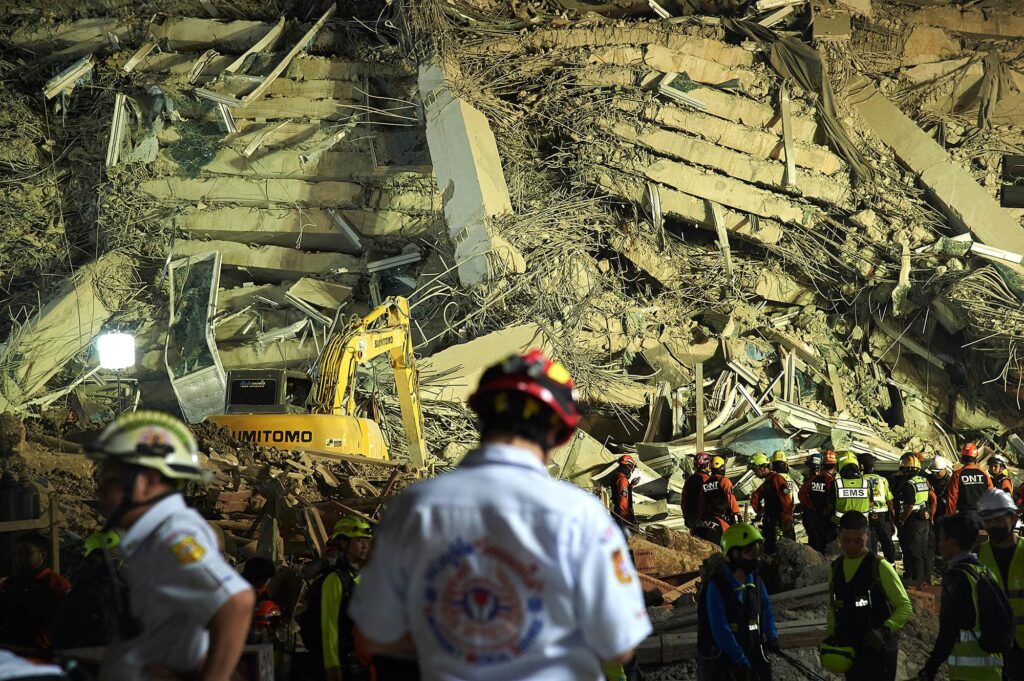At 1.20 pm on March 28, the U.S. Geological Survey detected a major earthquake of 7.7 magnitude 10 km deep in the active Sagaing Fault running through Myanmar’s second largest city, Mandalay. The earthquake rocked the region as far as Bangkok, which is located over 1,000 km away.
Sitting on a soft clay layer, Bangkok buildings and a large number of public infrastructures shook severely alongside properties in the other 17 provinces.
Almost half an hour passed by, and there was no official emergency notice issued to the public from the government. Earthquake monitoring agencies, including the Meteorological Department’s Earthquake Surveillance division and the Mineral Resources Department, posted and broadcast live via their FB pages, incoherently, trying to inform people about the situation as best they could.
There were no further instructions on what to do next for the civilians who had already been spooked by the incident and plunged into chaotic circumstances.
Almost at the same time, Prime Minister Paetongtarn Shinawatra, while on her government trip in Phuket with her Cabinet members, grasped the situation, calling for an urgent meeting to address the incident before briefing the public on television about the situation as well as immediate measures she instructed the agencies concerned, at around one and a half hour later, or around 2.30 pm.
Among those were the immediate dissemination of the information to the public through SMS and cell broadcast, the system through which text messages could be sent to the targets in a large number at once. (At present, the manual SMS message dissemination by the networks can send 200,000 at once. There reportedly are 100 million phone numbers in the country.)
It was learned later that her swift instruction did not reach the people. The SMS was delayed and messages reached people several hours later, more than six or seven hours at least — with unconfirmed information alongside. The public sentiment had since grown against the government’s reaction and delayed early warning and public alert system.
The PM on the next day called for a major meeting with all concerned agencies to discuss the problem and try to allay public concerns with additional measures and instructions. She was not happy with the reactions of the agencies under her supervision either. She asked them to explain to her as she had to explain to the people, saying what needed to be done and could be done more, as she, in her capacity as the Prime Minister, and her Interior Minister had already swiftly instructed them in the first hours of the incident.
From a tragic tsunami that hit the South of the country twenty years ago, it’s clear that disaster preparedness and response to handle major disasters in the country has gone backwards.
Shortly after the tsunami that struck the country on December 26, 2004, concerned agencies came up with the lessons learned, especially the introduction of an early warning and public alert system to inform people about disasters promptly so that they can have a better chance of survival.
The National Disaster Warning Center was set up afterwards in an attempt by the country to try to address major disasters properly, but over time, this center has been downsized and is placed under the Disaster Prevention and Mitigation Department, being plagued with bureaucratic procedures and almost nonfunctional.
What’s gone with it is the country’s disaster preparedness and response protocols. They were barely present during the major earthquake on Friday.
If Thailand has the critical lessons to learn about major disasters, this most recent earthquake just tells us one painful fact: It has never learned the lessons at all.
As of today, the Bangkok Metropolitan Administration (BMA) reported that 18 people have been killed, 33 more injured, and 78 more missing. Among these are those who are still trapped in the collapsed under-construction State Audit Office building in the Chatuchak area.
At the time of writing, their critical life-and-death 72 hours have passed. There is only one weak sign of life detected under the rubble.
Indie • in-depth online news agency
to “bridge the gap” and “connect the dots” with critical and constructive minds on development and environmental policies in Thailand and the Mekong region; to deliver meaningful messages and create the big picture critical to public understanding and decision-making, thus truly being the public’s critical voice


